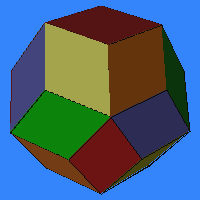Colorings
 Polyhedral
models may be colored in various ways. For making multi-colored paper
models, it is attractive to have adjacent faces of different colors,
but only certain schemes are compatible with the symmetry of the object.
The possible colorings for the faces, vertices, and edges of the platonic
solids are given here. These can be applied to other polyhedra with similarly
arranged components.
Polyhedral
models may be colored in various ways. For making multi-colored paper
models, it is attractive to have adjacent faces of different colors,
but only certain schemes are compatible with the symmetry of the object.
The possible colorings for the faces, vertices, and edges of the platonic
solids are given here. These can be applied to other polyhedra with similarly
arranged components.
For the cube, the six faces can be colored with just three colors if opposite faces are given the same color. The result is a 3-colored cube.
The eight faces of the octahedron can be colored in two ways. A 2-colored octahedron has a kind of "checker-board" pattern where the four faces of one color are in the planes of a tetrahedron. (A two-coloring of the faces of a polyhedron is always possible when an even number of faces meet at each vertex.) Alternatively, in the 4-colored octahedron, opposite faces are given the same color, so two faces of the same color never meet at a vertex. By duality, coloring the faces of an octahedron is equivalent to coloring the vertices of a cube, there is a corresponding 2-coloring and 4-coloring to the vertices of a cube.
For the twelve faces of the dodecahedron, four colors suffice (three faces of each color) as shown above. The 4-colored dodecahedron is chiral; it has one group of three like-colored faces arranged around each of the four 3-fold tetrahedral symmetry axes. In the above figure, we are looking down the axis for the red faces. Alternatively, a 6-colored dodecahedron has opposite faces of a common color. When extending the colored face planes to make a stellation, different colorings bring out different aspects of the structure, depending on the way in which the extended faces meet. An alternative 4-coloring of the dodecahedron with a tetrahedral arrangement puts groups of three of the same color together, which is a nice coloring for many of the tetrahedral stellations of the dodecahedron.
The twenty faces of the icosahedron can be colored as five groups of four. The 5-colored icosahedron is chiral and each group of four like-colored faces lie in the plane of a tetrahedron. So it is the interior of the compound of five tetrahedra. These colorings make for very attractive versions of the 59 stellations of the icosahedron.
The four Kepler-Poinsot polyhedra are stellations of the dodecahedron or icosahedron and make nice examples of the above coloring methods:
- small stellated dodecahedron: mono, 4-color, alt. 4-color, 6-color
- great dodecahedron: mono, 4-color, alt. 4-color, 6-color
- great stellated dodecahedron: mono, 4-color, alt. 4-color, 6-color
- great icosahedron: mono, 5-color
 Coloring
the edges of a dodecahedron or icosahedron is equivalent to coloring the
faces of a rhombic triacontahedron.
This follows from the way a
dodecahedron can be inscribed in a rhombic triacontahedron with the
dodecahedron edges being the short diagonals of the rhombic faces. Similarly,
an
icosahedron can be inscribed in a rhombic triacontahedron with the
icosahedron edges being the long diagonals of the rhombic faces. There
is a beautiful
5-colored
rhombic triacontahedron which is the
interior of the compound of five cubes. Other stellations
of the rhombic triacontahedron look very attractive when colored with
this pattern.
Coloring
the edges of a dodecahedron or icosahedron is equivalent to coloring the
faces of a rhombic triacontahedron.
This follows from the way a
dodecahedron can be inscribed in a rhombic triacontahedron with the
dodecahedron edges being the short diagonals of the rhombic faces. Similarly,
an
icosahedron can be inscribed in a rhombic triacontahedron with the
icosahedron edges being the long diagonals of the rhombic faces. There
is a beautiful
5-colored
rhombic triacontahedron which is the
interior of the compound of five cubes. Other stellations
of the rhombic triacontahedron look very attractive when colored with
this pattern.
Combining two of the above patterns, we find there are two nice ways to 5-color the rhombic enneacontahedron, one chiral and one reflexible.

Finally, an interesting 3-coloring of the faces of a rhombic triacontahedron has been pointed out to me recently by John Dalbec. It is chiral, with three 2-fold symmetry axes. To visualize it, notice that each color comes in two "chains" of five faces, and the centers of these six chains are six faces which lie in the planes of a cube. (These six faces are penetrated by the 2-fold axes of the coloring. There are also four 3-fold axes which permute the colors.)